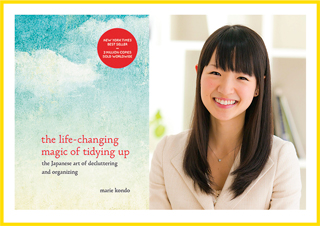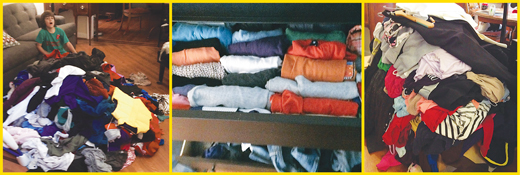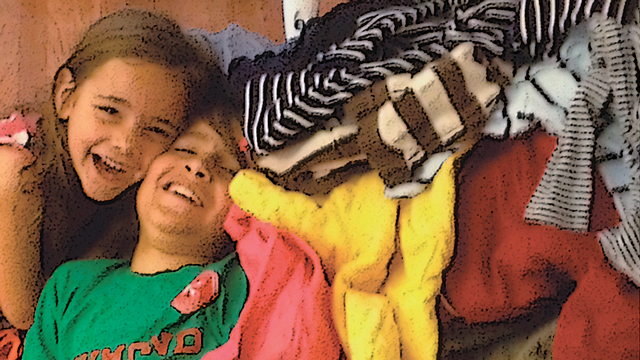“Your closet is so neat. I’ve seriously never seen a closet this tidy before.”
This is my sister talking. I pause. Dumbfounded. “Neat” and “tidy” are not words normally associated with me or with anything in my home. I hadn’t even attempted to clean my closet recently.
But then I remember, “Oh, right – we KonMari-ed it a few months ago.”
And that’s exactly what the KonMari Method is supposed to give me. When I do the work to be rid of the clothing that doesn’t bring me joy and find homes for every item which does, I don’t have to think about tidying my closet. I don’t have to organize and clean, because my closet just is what it is. My space is naturally tidy. Impressive, if I do say so myself.
What exactly is KonMari? Marie Kondo is a woman obsessed with being neat and organized. Since she was five years old, she has tried to figure out what would not only keep a home tidy but what could keep one from having to spend all her time tidying it again and again. She eventually created the KonMari Method and wrote the best-selling book, The Life-changing Magic of Tidying Up: The Japanese Art of Decluttering and Organizing.

Normally, I’m not into self-help books, but news of her method won me over – mostly with that idea of never having to tidy again. My family is not naturally neat. We prioritize fun and adventure over mopping the floor. My 6-year-old collects broken ribbon and heart-shaped rocks while my 9-year-old will just move to another room to find more space to play a new game. My husband constantly leaves his keys within two to three feet of our key bowl, and I like to store everything on the stairs for the eventual day my steps become an escalator, which carries my things up to their respective drawers and baskets. In other words, the 1-year-old is the tidiest among us, and he can’t even wipe his own bottom.
Of course, in her book, Marie Kondo calls me out on this: “The urge to point out someone else’s failure to tidy is usually a sign that you are neglecting to take care of your own space.”
Ugh, but true. I long to be neater. I hate when I can’t find something. I hate that vacuuming means I spend thirty to sixty minutes picking up the floors and putting stuff away before I can even begin. I hate that some of our stuff has nowhere to go but a countertop already overflowing with magazines and papers. Don’t get me wrong, I love my home and I love my family, but I want harmony to exist in our lives. I want our home to reflect our love for each other without taking over our time with each other.
Marie Kondo’s idea that every item in my home should bring us joy or should not live with us echoes this desire to have our space reflect our family life. I bought the book and began our KonMari experiment. Could a family of five (with almost as many pets) really do what Marie Kondo suggests? Could we take every item in a category and put it all on the floor of a room – and not leave it there to become a new cat bed? Could we take the time to hold every item and ask ourselves, “Does this spark joy?” without sparking an argument over how long it was taking?
The book itself turned out to be essential to success for us (and I don’t get any kickbacks for admitting that). Not only did it keep inspiring me to continue when the mere thought of removing all my books from the shelf made me suddenly want to run a week’s worth of errands, but it also had tips and details that an article or summary of KonMari (like this one) just couldn’t capture. The good news is that most people, who are KonMari-ing with the book, will be passing it along at the end of the process because the book has served its purpose. (Yes, you can have mine.)

The KonMari Method begins with tackling clothing, and I considered this our test run. I thought through all our possible categories of clothing and chose the least likely to cause attachment mayhem: socks. While I love a funky pair of socks, I’m not particularly attached to them. Plus, it was summertime so the only person wearing them on the regular was my husband. While we gathered all our socks in one giant pile, I discovered I had three drawers of them! Standing knee-deep in socks was not only eye-opening, it guaranteed we would still have enough socks even if we let go of everything we didn’t love.
We all participated by asking ourselves with every pair that fit: “Does this spark joy in me?” And this next part is important: I accepted my big kids’ decisions about socks they didn’t like because me liking them is not enough to get them on their feet anymore. Obviously, the baby didn’t get as much of a say, but if I didn’t find joy in those tiny socks, why would I be willing to cover delicious-to-behold, baby feet? When we were done, I had one drawer of socks that made me smile whenever I grabbed a pair.
We were sold! As we continued with each category of clothing, I was able to open up more and more drawer space so we didn’t need any fancy organization system in place. We already had enough drawers and closets once we let go of the joyless clothing and passed it along to a family who might feel happiness when wearing it. In fact, I have so much space now that I can clear off the tops of my bureaus by storing jewelry boxes and headphones inside them.
Folding clothing is another aspect of KonMari. In the book, Kondo writes, “first, fold each lengthwise side of the garment toward the center (such as the left-hand, the right-hand, sides of the shirt) and tuck the sleeves in to make a long rectangular shape. It doesn’t matter how you fold the sleeves. Next, pick up one short end of the rectangle and fold it toward the other short end. Then fold again, in the same manner, in halves or in thirds.” Got that? Yeah, me neither. I honestly did not understand her folding method until I watched her YouTube videos. Basically, everything is folded to stand up and layered in a vertical rather than horizontal fashion so nothing is crushed or out of eyesight when I open a drawer. My husband and I use this folding method, but I do not use it with the kids. I don’t want them spending laundry time attempting to fold in a certain way and getting frustrated when the clothes don’t stay upright. I value my big kids putting away their own clothing in a timely and joyful manner more than extra drawer space. And although the folding method promises fewer wrinkles, my clothing merely has the same wrinkles in new places. However, the extra drawer space is worth it.

Our next category? Books and papers. I adore reading and could not imagine a home with fewer books. I love every subject I’ve studied, and as it turns out, I’m one of those people who rereads books. But I still took every book off the shelf like the author suggested and recognized that so many titles were about my ego (Look what I’ve read!) and not about sharing my love of words with others. I also was just ready to let other people find joy in the books I’ve treasured over the years. We did the same with our children’s books, although my kids were not as motivated to let go of their books as we were. I took this desire to keep their books as a badge of honor rather than a KonMari failure. They love reading and maybe they need to reread those books a hundred more times before they can let them go. I understand that as I had decades with my books before releasing them into the world again. We all clearly kept more books than the author does, but when I look at my bookshelf now, I smile because everything up there brings me joy.
Next, I really wanted to get rid of my random piles of paper, but I am convinced I need everything and my kids are convinced that we only love them when we keep everything they’ve ever made including a stick figure dog drawn on a gum wrapper. (To be fair, it is cute.) The book reminded me that when it comes to the majority of information, if I really need it, it’s available on the Internet. Sadly, this isn’t true for my kids’ school and artwork, which is why they are in a giant box, stashed in our family room cabinets. Although boxes are a big recommendation for the storage side of KonMari – especially shoeboxes and iPhone boxes – I don’t think she had boxes of everything my kids ever touch in mind. But us keeping these things sparks joy in my children’s faces, so I have not pushed it, even as we reached the chapter on discarding sentimental items.

Our hard work has paid off, but we still have far to go to tackle komono or miscellaneous items as well as the sentimental. Although my mindset around sentimental items is set within a desire to let them go, the sheer amount of sentimental items we have to go through means I need more time than I have right now. Going from a box of photos to five photos per vacation day would be fantastic, especially for my computer memory, but I have over 30,000 digital photographs. I also know my children see all of their toys as sentimental. I need to think of it as if just 10 percent of their toys are given away, we will be closer to a home of harmony.
And as Kondo says, “As you put your house in order and decrease your possessions, you’ll see what your true values are, what is really important to you in your life. But don’t focus on reducing, or on efficient storage methods, for that matter. Focus instead on choosing the things that inspire joy and on enjoying life according to your own standards.”
The beauty of the KonMari process for children is it teaches an inherent appreciation for what we have. Instead of owning things out of fear of not having enough or out of fear of needing it at some date, we can live in the moment and draw joy from our surroundings. There’s a spirit to KonMari where we can thank our shoes for getting us out and home again and thank our piano for bringing music to our lives. We can even be grateful to the items we discard, for they brought us joy in the purchasing or in the times we wore or read them.
This has been my attitude as well, as we continue on the KonMari journey. I apply the method slowly, reasonably, and happily, and whenever I’m stuck,
I picture a family finding my favorite philosophy book or black cardigan at the Goodwill and giving it a home and the love I could no longer give. KonMari is a bit of a marathon, which the book states can easily take six months or more to complete, and for our large, busy family, we value not creating stress during this effort to not live in a stressful, cluttered environment.
When I am overwhelmed at the prospect of another category to sort – like photographs or Barbies – I walk over to the places in my home that shine – like our bookshelves and neat and tidy closets. I want that joy for every room and for everyone in my home so I push on, because for me, the life-changing magic of tidying resides in my love of my family. They spark my joy to trust in this process of contentment.
Like Marie Kondo says: “Once you have experienced what it’s like to have a truly ordered house, you’ll feel your whole world brighten… this is what I call the magic of tidying. And the effects are stupendous. Not only will you never be messy again, but you’ll also get a new start on life.”




